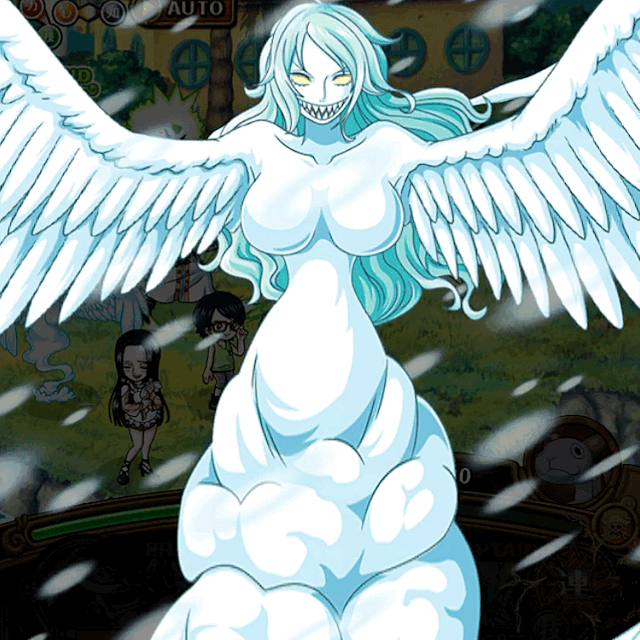Fanclub Monet FC
- Thread starter Buusatan94
- Start date
More options
Who Replied?I was thinking that cp0 speech of the other day last chapter. Is the best thing that Oda did for Monet. In my opinion, after the first time that punk hazard was damaged, a laboratory still working on. And in the second time, oda draw the block c with no damage. So, we could think that one laboratory in punk hazard, was so good in order to be safe inside. And maybe, in the two imes was the block C the laboratory witch don´t have damages. (Where Monet was in the second time...) So, I think it is only a good point for monet
In case anyone's interested, I've publicly posed the question of how non-Monet fans can explain away Monet's heart being intact.
https://worstgen.alwaysdata.net/forum/threads/why-did-oda-draw-monets-heart-intact.12398/
Thus far only a couple of people have responded, but their responses have been unconvincing, as expected.
https://worstgen.alwaysdata.net/forum/threads/why-did-oda-draw-monets-heart-intact.12398/
Thus far only a couple of people have responded, but their responses have been unconvincing, as expected.
I find it very interesting. Let Oda make these two images of Monet dressed in Asian clothes. "She may be in wano in the future" She is a yuki onna ...
I know they are images of the mobile game ... But knowing Oda, everything counts.
I was also investigating how many people outside of wano have drawn like this in the game. And there is only Monet and sugar


I know they are images of the mobile game ... But knowing Oda, everything counts.
I was also investigating how many people outside of wano have drawn like this in the game. And there is only Monet and sugar




Quick theory. If we count the eight moons of robins past, we add that the middle circle is the earth and we also add that the kozuki clan tattoo is a bird.
Bird, more land, plus eight moons. Could it be a clue that monet, the astrologer will appear in wano finally being the yuki onna?
Correct me if I'm wrong, but aren't there only seven celestial objects surrounding the Earth there? I do like the idea that the set of circles on the Kozuki insignia represents those objects, especially since it doesn't seem to incorporate any moon imagery despite being effectively named "Moonlight", but if the number of objects is off then it falls apart.
Let's review the image ... We are going to go from left to right. Counting the eight moons

(above the scientist's head and behind the ruler. You see a piece of the eighth moon.
I repeat, between the two open arms of the ohara scientist. You can see behind the ruler the eighth moon or at least a piece of it )
We can see two on the left. Above the earth, there is one. And under the earth there is another. But it is hidden behind the semicircular rule. Notice, that you can see a little of the sphere of the moon and we see that there is a wire there where a moon should circulate.
On the right, we have four moons. Three big ones and a small one attached to one of them.
Two from the left. More the hidden one below, more the one above. Four moons. Plus the other four on the right. We have the eight moons.

So yes, in that image of ohara there are eight moons. I repeat, the hidden moon of which we only see a piece. It is above the scientist's head and behind the ruler. We only see a piece of this moon but we do see that there is the conduit through which it must circulate.
So in the image of the kozuki. It takes us to ohara. The earth, the eight moons and a bird.
Reinforcing, that we need a bird that knows astronomy
I'm so glad you asked me that question.
Let's review the image ... We are going to go from left to right. Counting the eight moons

(above the scientist's head and behind the ruler. You see a piece of the eighth moon.
I repeat, between the two open arms of the ohara scientist. You can see behind the ruler the eighth moon or at least a piece of it )
We can see two on the left. Above the earth, there is one. And under the earth there is another. But it is hidden behind the semicircular rule. Notice, that you can see a little of the sphere of the moon and we see that there is a wire there where a moon should circulate.
On the right, we have four moons. Three big ones and a small one attached to one of them.
Two from the left. More the hidden one below, more the one above. Four moons. Plus the other four on the right. We have the eight moons.

So yes, in that image of ohara there are eight moons. I repeat, the hidden moon of which we only see a piece. It is above the scientist's head and behind the ruler. We only see a piece of this moon but we do see that there is the conduit through which it must circulate.
So in the image of the kozuki. It takes us to ohara. The earth, the eight moons and a bird.
Reinforcing, that we need a bird that knows astronomy
Let's review the image ... We are going to go from left to right. Counting the eight moons

(above the scientist's head and behind the ruler. You see a piece of the eighth moon.
I repeat, between the two open arms of the ohara scientist. You can see behind the ruler the eighth moon or at least a piece of it )
We can see two on the left. Above the earth, there is one. And under the earth there is another. But it is hidden behind the semicircular rule. Notice, that you can see a little of the sphere of the moon and we see that there is a wire there where a moon should circulate.
On the right, we have four moons. Three big ones and a small one attached to one of them.
Two from the left. More the hidden one below, more the one above. Four moons. Plus the other four on the right. We have the eight moons.

So yes, in that image of ohara there are eight moons. I repeat, the hidden moon of which we only see a piece. It is above the scientist's head and behind the ruler. We only see a piece of this moon but we do see that there is the conduit through which it must circulate.
So in the image of the kozuki. It takes us to ohara. The earth, the eight moons and a bird.
Reinforcing, that we need a bird that knows astronomy

The real question that remains in my mind, though, is whether they're meant to be moons or planets. It's not too important for the sake of your argument, as the connection of "eight objects around the Earth" still holds up, I'm just extremely curious what Oda wants to convey with this model.
Does the One Piece world believe in geocentrism, with the Earth as the center of its solar system, implying that this is an inaccurate model?
Is the One Piece world actually geocentric somehow? If so, does the sun revolve around the Earth too, or is the Earth itself heliocentric while also being so large that the other planets behave geocentrically?
Obviously, they aren't all so close as to be seen in the night sky, at least not in the same way that what we call "the moon" is, so that really calls into question their size. I wonder if they can be seen among the stars though, similar to the closest planets to our Earth in our solar system?
If they are indeed planets, how big would this world need to be in order for them to orbit it as if they were moons instead of orbiting the sun and still be so far as to not be seen at the scale of the moon?
Do these planets support life? Is that how the Space Pirates came to this world's moon; because they were close enough to do so rather than needing to travel lightyears to reach it?
And most importantly, if Monet is in fact an astronomer, do they have any special properties that would be unusually helpful for celestial navigation?
Last edited:
I noticed that little bit hidden underneath the bottom-most object too, but I wasn't sure if it should be counted. I double-checked the full-color version, and sure enough, it wasn't removed and was given the same color as the object it's next to, so perhaps it was indeed intended to be a satellite around that particular object.

The real question that remains in my mind, though, is whether they're meant to be moons or planets. It's not too important for the sake of your argument, as the connection of "eight objects around the Earth" still holds up, I'm just extremely curious what Oda wants to convey with this model.
Does the One Piece world believe in geocentrism, with the Earth as the center of its solar system, implying that this is an inaccurate model?
Is the One Piece world actually geocentric somehow? If so, does the sun revolve around the Earth too, or is the Earth itself heliocentric while also being so large that the other planets behave geocentrically?
Obviously, they aren't all so close as to be seen in the night sky, at least not in the same way that what we call "the moon" is, so that really calls into question their size. I wonder if they can be seen among the stars though, similar to the closest planets to our Earth in our solar system?
If they are indeed planets, how big would this world need to be in order for them to orbit it as if they were moons instead of orbiting the sun and still be so far as to not be seen at the scale of the moon?
Do these planets support life? Is that how the Space Pirates came to this world's moon; because they were close enough to do so rather than needing to travel lightyears to reach it?
And most importantly, if Monet is in fact an astronomer, do they have any special properties that would be unusually helpful for celestial navigation?

The real question that remains in my mind, though, is whether they're meant to be moons or planets. It's not too important for the sake of your argument, as the connection of "eight objects around the Earth" still holds up, I'm just extremely curious what Oda wants to convey with this model.
Does the One Piece world believe in geocentrism, with the Earth as the center of its solar system, implying that this is an inaccurate model?
Is the One Piece world actually geocentric somehow? If so, does the sun revolve around the Earth too, or is the Earth itself heliocentric while also being so large that the other planets behave geocentrically?
Obviously, they aren't all so close as to be seen in the night sky, at least not in the same way that what we call "the moon" is, so that really calls into question their size. I wonder if they can be seen among the stars though, similar to the closest planets to our Earth in our solar system?
If they are indeed planets, how big would this world need to be in order for them to orbit it as if they were moons instead of orbiting the sun and still be so far as to not be seen at the scale of the moon?
Do these planets support life? Is that how the Space Pirates came to this world's moon; because they were close enough to do so rather than needing to travel lightyears to reach it?
And most importantly, if Monet is in fact an astronomer, do they have any special properties that would be unusually helpful for celestial navigation?
Well, about monet. I believe that at this moment Ode wanted to shout to us that astrology is important. We are going to think about the easiest answer. Why does Oda draw so many moons instead of just one? If the astrology in one piece is not important. Why are there so many? It smells from far, that there is a plan behind all this. Anyway, although right now we can see only seven. (I have realized thanks to you that that was not a moon). Could it be that we are still right? That there are still eight moons? That there is a hidden moon behind the earth or that it is far away but the kouzuki know that there was an octave?
If we go to the image of the kozuki tattoo. The easiest thing is to think, that the tattoo spheres. They are the moon and the eight stars. But of course, if there are eight stars and in ohara there were only seven. Either one escapes them, or at that moment it is behind the earth. What I mean, that I think it can be very evident that that scene of ohara with the earth and the moon and the spheres of the kozuki clan is the same. Let's think. We only need one moon for the drawing to make sense. It is not weird. What would it be but that?
Seriously, throughout this forum I have read some good monet theorists. Among some, you. I would like to further anilize the relationship kozuki ohara and the moons. Let's remember. That the adepts of oden, tattooed a crescent moon. And that many wano surnames, has to do with the moon. Like shimotsuki ... What I mean is that I think we are in a good line to think that the tattoo and the moons is that same. But maybe we are missing a moon. That perhaps, is hidden at that time or in ohara was not discovered. Be that as it may. I believe that the essence of an astrologer is clearly necessary. Recall, that during the great royal era of sea travel. It was essential to know astrology. In fact, the flag of Portugal has an astrolabe drawn since the astrological discoveries were fundamental.
And if we combine the studies of nami, robin and monet. We have archaeoastronomy. A science created in yesteryear just to study ancient civilizations. Doesn't this sound a bit like an empty century? ( I studied all that in my university career. )
@Buusatan94 add me to the list

76th most popular One Piece character in the world, babyyy!!!
A little lower than her mid-term rank of 59th, but hey, she made it to the top 100!
88th in continental Asia
17th in Oceania
55th in North America
78th in Japan
82nd in Latin America/the Caribbean
79th in Europe
78th in the Middle East
And again, sadly did not rank in Africa, but I'm just going to assume she was 101st
Missing the top 50 unfortunately excludes her from the commemorative art piece that Oda is going to put together, but he said that there'd be something else too, so maybe he'll do something special for the other 50? Who knows?
If she comes back, I imagine her popularity will spike, so perhaps she'll have a stronger showing next time around, probably when the series ends
Count me in! I’m also a strong believer that Monet is still alive. I have a discussion with Tokiro Oumaga about how to bring Monet back into the story. I was thinking that she might be dead, but Vegapunk found her and resurrected her off screen; or in better case, she’s in comatose state, but Vegapunk found her and saved her life. But after being shocked that much, Monet is amnesiac, although she still retains her DF power. So she goes under new identity & works for Vegapunk, only to be reintroduced again later & meet the Straw Hats. Straw Hats recognized her, but she has no idea who Straw Hats are. Therefore having amnesia as her redemption arc sounds pretty good, and Straw Hat Pirates can forgive what she did in Punk Hazard because she has redeemed herself with her new identity and will eventually let her join the crew. SHP haven’t had any crew member dealing with amnesia, although it sounds Sabo-like, but Sabo doesn’t have new identity & retains his memory back, while Monet sticks with her new identity to be with Straw Hat Pirates.
Maybe Monet’s conflict later is when her memory slowly starts going back, and remembering how awful she was, she still want to stick with her new identity; and the conflicting memories may make Monet is some sort of having dual personality, where her “evil” counterpart tries to take over her new “good” counterpart multiple times. It sounds pretty good for me, because no Straw Hat crew deals conflict with themselves. It’s always involving other people or important person in respective crew’s life.
Maybe Monet’s conflict later is when her memory slowly starts going back, and remembering how awful she was, she still want to stick with her new identity; and the conflicting memories may make Monet is some sort of having dual personality, where her “evil” counterpart tries to take over her new “good” counterpart multiple times. It sounds pretty good for me, because no Straw Hat crew deals conflict with themselves. It’s always involving other people or important person in respective crew’s life.
@Buusatan94 can I join?














